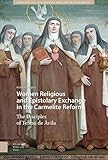Women Religious and Epistolary Exchange in the Carmelite Reform : The Disciples of Teresa de Avila / Bárbara Mujica.
Material type: TextSeries: Gendering the Late Medieval and Early Modern World ; 10Publisher: Amsterdam : Amsterdam University Press, [2020]Copyright date: ©2020Description: 1 online resource (328 p.)Content type:
TextSeries: Gendering the Late Medieval and Early Modern World ; 10Publisher: Amsterdam : Amsterdam University Press, [2020]Copyright date: ©2020Description: 1 online resource (328 p.)Content type: - 9789048551569
- online - DeGruyter
| Item type | Current library | Call number | URL | Status | Notes | Barcode | |
|---|---|---|---|---|---|---|---|
 eBook
eBook
|
Biblioteca "Angelicum" Pont. Univ. S.Tommaso d'Aquino Nuvola online | online - DeGruyter (Browse shelf(Opens below)) | Online access | Not for loan (Accesso limitato) | Accesso per gli utenti autorizzati / Access for authorized users | (dgr)9789048551569 |
Frontmatter -- Table of Contents -- Prologue -- Introduction -- Part I María de San José -- 1. The (Almost) Silenced Epistolary Pen of María de San José -- 2. Drama in Seville -- 3. On to Portugal: The Lisbon Carmel, 1584–1603 -- 4. Battles: The English, The Dutch, and the Discalced Hierarchy -- 5. Trials: Prison, Illness, and Death -- Part II Ana de Jesús -- 6. Paris and Beyond -- 7. In the Low Countries -- Part III Ana de San Bartolomé -- 8. Who Was Ana de San Bartolomé? -- 9. Ana and the French -- 10. The Antwerp Foundation -- 11. Friends and Enemies: The Last Years -- 12. The Ones Who Stayed Behind : The Letters of Catalina de Cristo to Ana de San Bartolomé -- Conclusion -- About the Author -- Index
restricted access online access with authorization star
http://purl.org/coar/access_right/c_16ec
The sixteenth century was a period of crisis in the Catholic Church. Monastic reorganization was a major issue, and women were at the forefront of charting new directions in convent policy. The story of the Carmelite Reform has been told before, but never from the perspective of the women on the front lines. Nearly all accounts of the movement focus on Teresa de Avila, (1515-1582), and end with her death in 1582. Women Religious and Epistolary Exchange in the Carmelite Reform: The Disciples of Teresa de Avila carries the story beyond Teresa's death, showing how the next generation of Carmelite nuns struggled into the seventeenth century to continue her mission. It is unique in that it draws primarily from female-authored sources, in particular, the letters of three of Teresa's most dynamic disciples: María de San José, Ana de Jesús and Ana de San Bartolomé.
Mode of access: Internet via World Wide Web.
In English.
Description based on online resource; title from PDF title page (publisher's Web site, viewed 27. Jan 2023)


